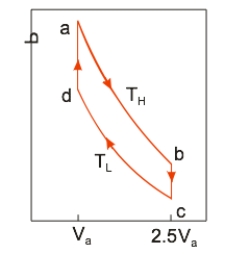 An ideal heat engine uses 0.01 mole of gas and operates between a hot reservoir at TH = 400 K and cold reservoir at TL = 300 K, in a cycle from a→b→c→d→a. From a→b the gas undergoes an isothermal expansion, changing its volume from Va to 2.5Va. From b→c, the pressure is reduced at a constant volume. From c→d, the gas undergoes an isothermal compression, and from d→a, the pressure is increased at a constant volume until the gas is back at the original condition at a. If the engine operates at 50 cycles per second, the power output is
An ideal heat engine uses 0.01 mole of gas and operates between a hot reservoir at TH = 400 K and cold reservoir at TL = 300 K, in a cycle from a→b→c→d→a. From a→b the gas undergoes an isothermal expansion, changing its volume from Va to 2.5Va. From b→c, the pressure is reduced at a constant volume. From c→d, the gas undergoes an isothermal compression, and from d→a, the pressure is increased at a constant volume until the gas is back at the original condition at a. If the engine operates at 50 cycles per second, the power output is
A) 381 W.
B) 45.8 W.
C) 1145 W.
D) 415 W.
E) 1525 W.
Correct Answer:
Verified
Q3: A heat engine absorbs 70 kcal of
Q4: A heat engine absorbs heat Q from
Q7: A substance undergoes a series of reversible
Q12: A refrigerator has a coefficient of performance
Q14: A heat engine operating between the temperatures
Q23: A refrigerator has a coefficient of performance
Q83: The maximum theoretical thermal efficiency of a
Q84: A steam engine with a boiler temperature
Unlock this Answer For Free Now!
View this answer and more for free by performing one of the following actions

Scan the QR code to install the App and get 2 free unlocks

Unlock quizzes for free by uploading documents